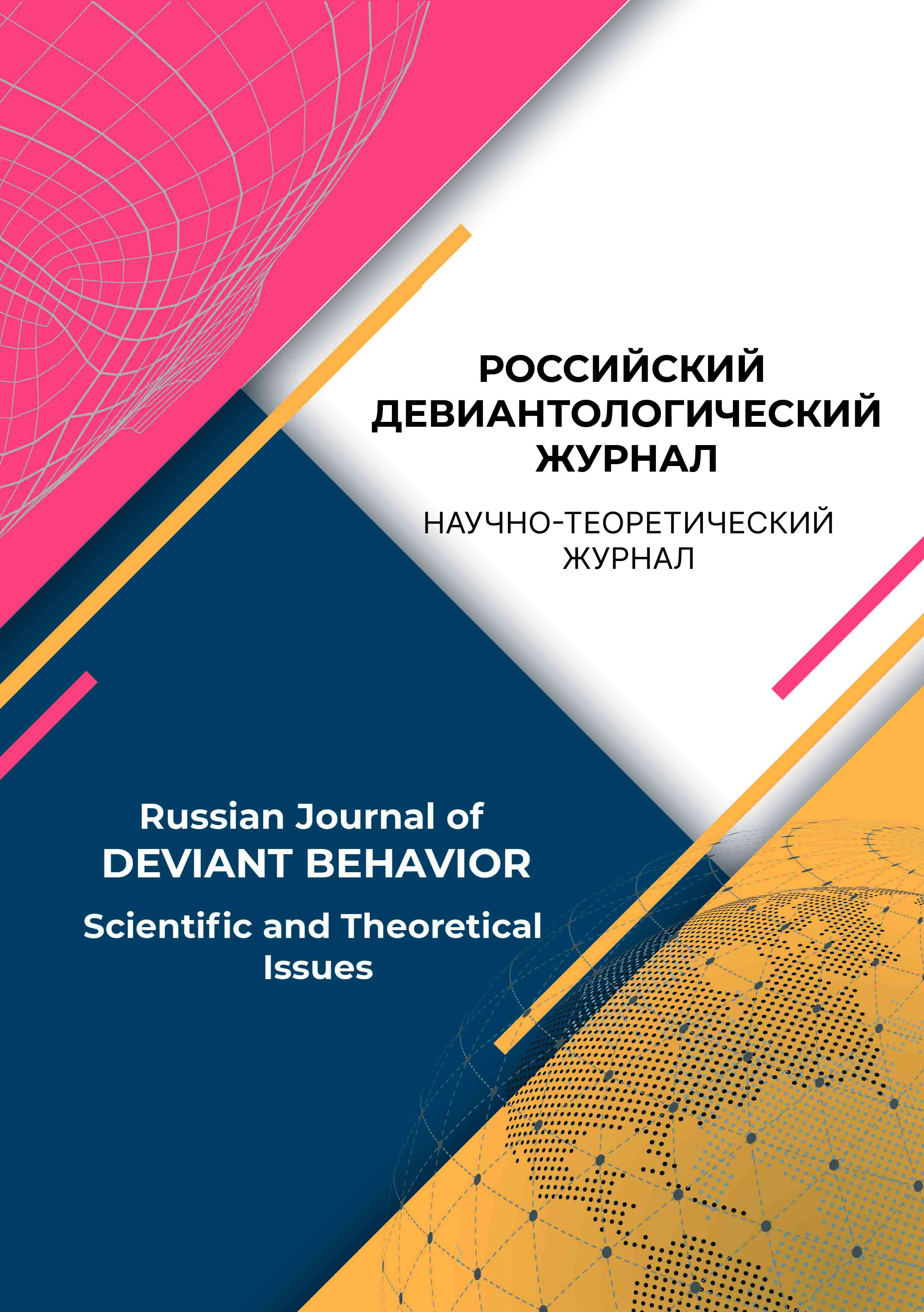from 01.01.2022 to 01.01.2023
Saint-Petersburg, St. Petersburg, Russian Federation
g. Sankt-Peterburg, St. Petersburg, Russian Federation
UDC 159.9.072
Introduction. The article deals with the significance of service loyalty as a promising psychological resource that can be used in the prevention of disciplinary violations among employees of internal affairs bodies. Loyalty as a structural component of personal reliability of employees is a significant characteristic of personality of dynamic nature, which enables to ensure its formation and development in professional activity. Research methods. General scientific methods of theoretical analysis, empirical methods, methods of psychological practice (training), psychodiagnostic techniques were used in the research: Questionnaire of J. Meyer and N. Allen “Organisational Commitment Scale”, S.S. Baranskaya's Method of measuring loyalty, V.I. Dominyak's Method “The possibility of realising motives”, L.A. Yasyukova’s test “Legal Consciousness”. Mathematical processing of the results included methods of descriptive, comparative and factor analysis using the statistical package “SPSS Statisticsver. 22.0” with the Mann-Whitney U-criterion. Results. The possibilities of service loyalty as a personal resource for solving the challenges of disciplinary violations among employees of internal affairs bodies were determined. The peculiarities of loyalty of employees having disciplinary sanctions reflecting low level of affective, continued and normative loyalty, work loyalty, assessment of possibilities of realisation of motives were established. The factor structure of loyalty is revealed, where the values of professional activity, loyalty to profession, psychological well-being and social acceptance, work and professional community loyalty, satisfaction with activity and organisational culture are considered the leading ones. The results of psychological training aimed at the formation and development of loyalty were analysed. Statistically reliable, significant shifts (p ≤ 0.05) in the loyalty indicators of employees who participated in the psychocorrectional work were identified, proving the possibility of changing the loyal attitude of employees.
service loyalty, psychological resources of service loyalty, prevention of disciplinary violations, training of loyalty formation and development
1. Baranskaya, S. S. (2011). Metodika izmereniya loyal'nosti. Psihologicheskie issledovaniya, 4 (15). https://doi.org/10.54359/ps.v4i15.867
2. Golubkov, S. V. (2004). Loyal'nost' personala kompanii: psihologicheskaya struktura, formirovanie i metodika izmereniya. Upravlenie personalom, 10 (87), 62–64.
3. Goncharova, N. A., Sarsenova A. A. (2020). Znachenie sluzhebnoj loyal'nosti v obespechenii lichnostnoj nadezhnosti sotrudnikov organov vnutrennih del. V A. A. Rozhkov (red.), Aktual'nye problemy psihologii pravoohranitel'noj deyatel'nosti: koncepcii, podhody, tekhnologii (Vasil'evskie chteniya - 2020): materialy mezhdunarodnoj nauchno-prakticheskoj konferencii, (Sankt-Peterburg, 23 aprelya 2020 goda, str. 128–131). Saint Petersburg: Sankt-Peterburgskij universitet MVD Rossii.
4. Gornostaev, S. V. (2016). Sluzhebnaya loyal'nost' sotrudnikov kak nauchnaya problema i faktor obespecheniya bezopasnosti i effektivnosti v funkcionirovanii ugolovno-ispolnitel'noj sistemy. Chelovek: prestuplenie i nakazanie, 1 (92), 133–138.
5. Dominyak, V. I. (2006). Organizacionnaya loyal'nost': osnovnye podhody. Menedzher po personalu, 4, 34–40.
6. Dushkin, A. S., Shchelkushkina, E. A. (2015). Psihologo-pravovoj analiz prichin, uslovij i faktorov narushenij sluzhebnoj discipliny i zakonnosti sotrudnikami policii. Prikladnaya yuridicheskaya psihologiya, 1, 89–99.
7. Kubyshko, V. L. (2008). Psihologicheskoe obespechenie profilaktiki narushenij sluzhebnoj discipliny v organah vnutrennih del. Pod red. V. L. Kubyshko. V Hrestomatiya po yuridicheskoj psihologii. Osobennaya chast'. Psihologicheskaya sluzhba v pravoohranitel'nyh organah (str. 40–45). Moskow.
8. Magura, M. I., Kurbatova, M. B. (2001). Sovremennye personal-tekhnologii. Moskow: Biznes-shk. «Intel-Sintez».
9. Medvedickova, L. V. (2019). Disciplinirovannost' sotrudnika organov vnutrennih del: soderzhanie i puti formirovaniya v processe professional'noj podgotovki. Mir nauki, kul'tury, obrazovaniya, 5 (78), 218-220. https://doi.org/10.24411/1991-5497-2019-00091
10. Sarsenova, A. A. (2023). Sluzhebnaya loyal'nost' v strukture lichnostnoj nadyozhnosti sotrudnikov organov vnutrennih del: dis. … kand. psihol. nauk. Saint Petersburg. URL: https://mvd.ru/upload/site125/dissertaciy/2023/5.3.9./sarsenova_a_a/Dissertatsiya_Sarsenova_.pdf
11. Sochivko, D. V., Bondyreva, S. K. (2019). Metodologiya i metod issledovaniya prosocial'nogo povedeniya. Prikladnaya yuridicheskaya psihologiya, 4 (49), 23–33.
12. Sochivko, D. V. (2020). Psihodinamika ekzistencial'no-lichnostnyh transformacij lichnosti v processe obucheniya i sluzhby v zakrytyh social'nyh sistemah. Prikladnaya yuridicheskaya psihologiya, 2 (51), 24–33.
13. Arnold, H. J., & Feldman, D. C. (1982). A multivariate analysis of the determinants of job turnover. Journal of Applied Psychology, 67 (3), 350–360. https://doi.org/10.1037/0021-9010.67.3.350
14. Buchanan, B. (1974). Building organizational commitment: The socialization of managers in work organizations. Administrative Science Quarterly, 19 (4), 533–546. https://doi.org/10.2307/2391809
15. Meyer, J. P., & Allen, N. J. (1984). Testing the “side-bet theory” of organizational commitment: Some methodological considerations. Journal of Applied Psychology, 69 (3), 372–378. https://doi.org/10.1037/0021-9010.69.3.372
16. Wiener, Y., & Gechman, A. S. (1977). Commitment: A behavioral approach to job involvement. Journal of Vocational Behavior, 10 (1), 47–52. https://doi.org/10.1016/0001-8791(77)90041-0
17. Michaels, C. E., & Spector, P. E. (1982). Causes of employee turnover: A test of the Mobley, Griffeth, Hand, and Meglino model. Journal of Applied Psychology, 67 (1), 53–59. https://doi.org/10.1037/0021-9010.67.1.53
18. Reilly, R. R., Brown, B., Blood, M. R., & Malatesta, C. Z. (1981). The Effects of Realistic Previews: A Study and Discussion of the Literature. Personnel Psychology, 34 (4), 823–834. https://doi.org/10.1111/j.1744-6570.1981.tb01433.x
19. Sager, J. K., & Johnston, M. W. (2013). Antecedents and Outcomes of Organizational Commitment: A Study of Salespeople. Journal of Personal Selling and Sales Management, 9 (1), 30–41. https://api.semanticscholar.org/CorpusID:140953322
20. Stumpf, S. A., & Hartman, K. (1984). Individual Exploration to Organizational Commitment or Withdrawal. Academy of Management Journal, 27 (2), 308–329.















